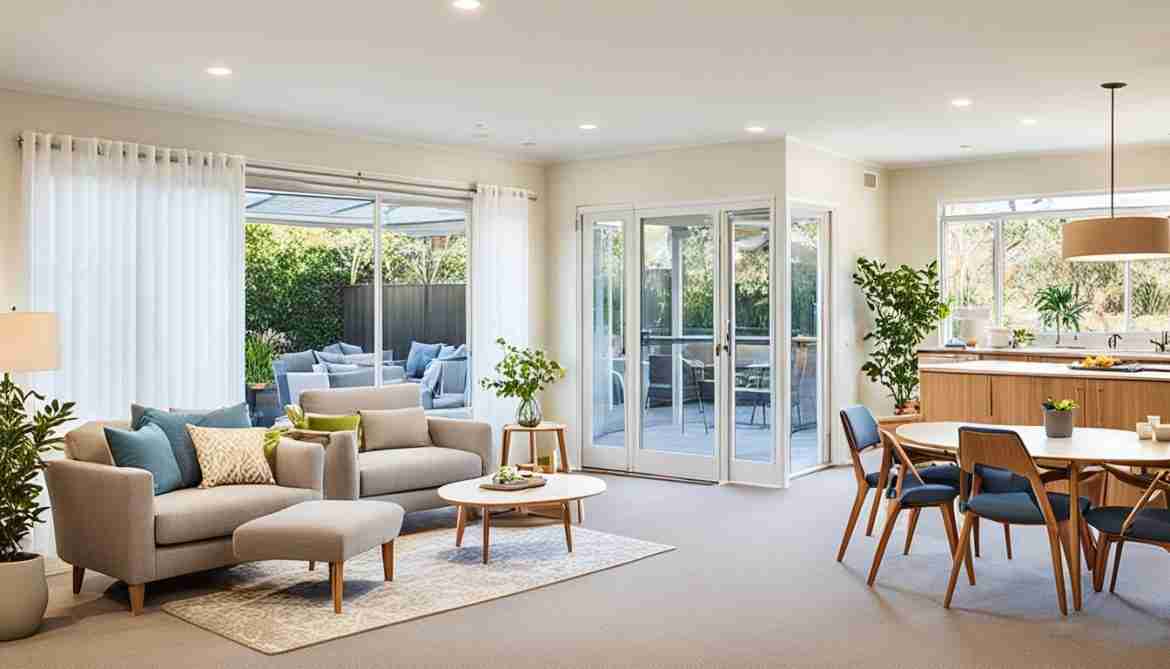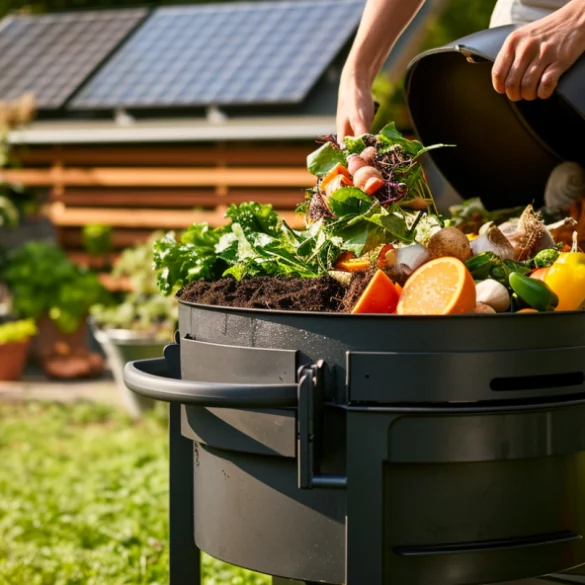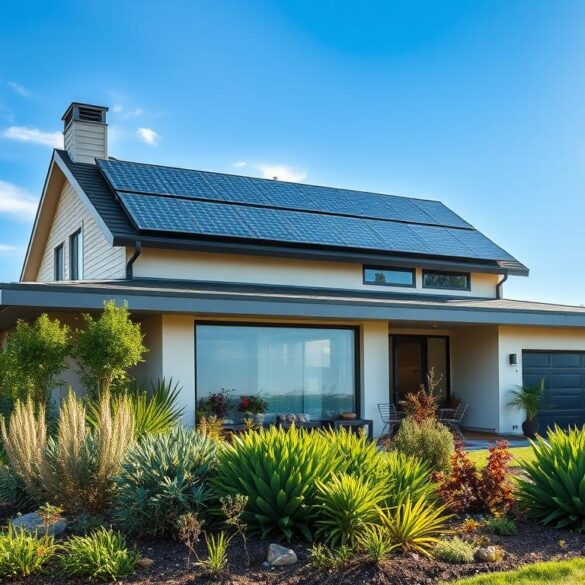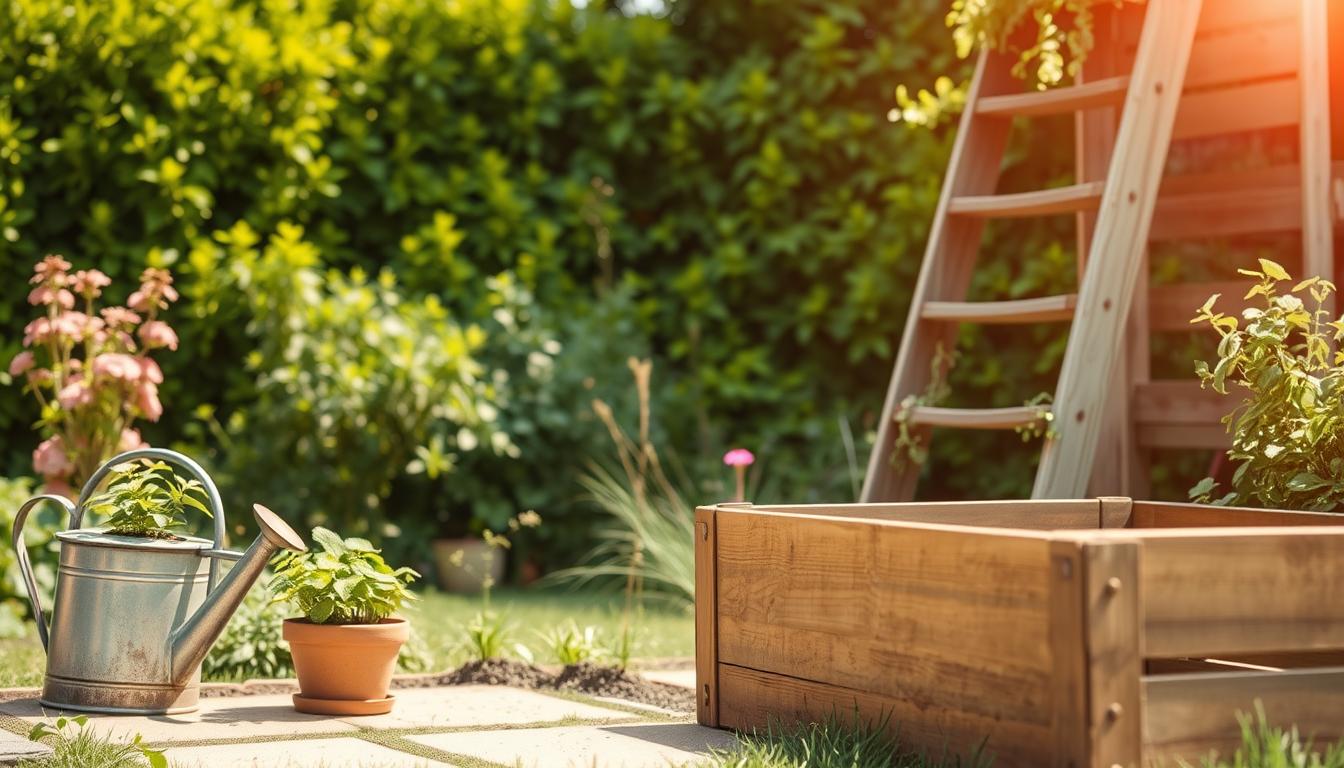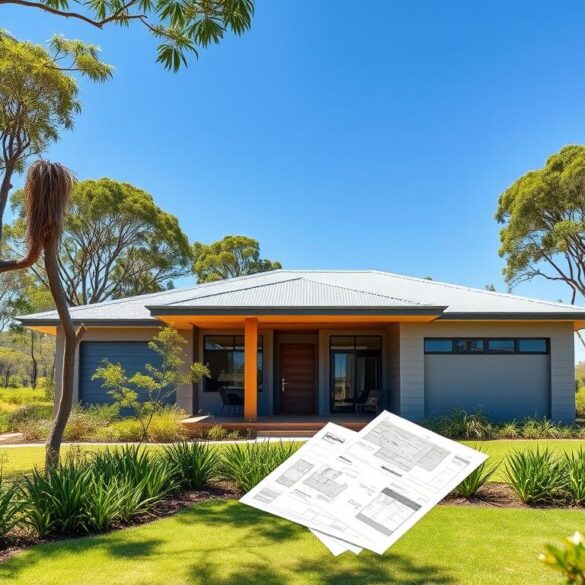Have you thought about how your house could help as you get older?
Senior livable housing design in Australia is about making homes easy for the elderly. These homes change to fit what people need as they age. Livable Housing Australia (LHA) came from a big talk on universal home design1. It sets rules that make sure houses are good to live in for a long time. The aim is to not just be easy to get around in but to be safe, comfy, and simple to use, no matter your age.
LHA works with many groups, like community and consumer ones, the government, and businesses. The goal is for all new Australian homes to be easy to live in by 20201. This matches up with studies showing 1 in every 5 Australians has a disability. And, there’s a big chance any home might need to help someone with a disability1. Making homes with these special designs during the planning stage saves a lot of money and makes everyone safer1.
Key Takeaways
- LHA promotes the inclusion of accessibility features in all new Australian homes.
- There is a high likelihood that homes will need to accommodate individuals with disabilities.
- Integrating livable design elements during the initial construction phase is more cost-effective.
- Homes designed with livable principles are safer and more functional for everyone, including seniors.
- Falls in the family home are a significant cause of injuries, highlighting the importance of livable homes.
Introduction to Livable Housing Design for Seniors
Livable Housing Design (LHD) is vital for seniors in Australia. It focuses on making homes inclusive and accessible. The National Construction Code (NCC) 2022 is updating rules to make homes better for seniors. This aims to improve the lives of older Australians.
The Need for Livable Housing
The NCC 2022 is making changes for older and disabled people2. It affects all Type 1a and Type 2 homes, helping a wide range of people3.
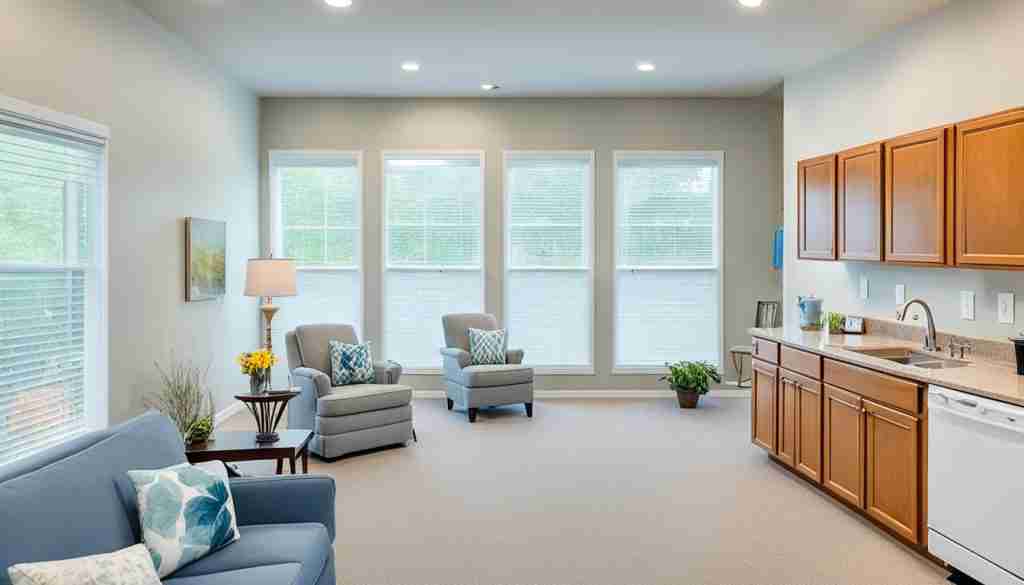
These updates are crucial for retirement homes. They make it easier for those with less mobility to live comfortably4.
Understanding the Core Principles
LHD is about making homes adaptable for everyone. It includes things like step-free areas and wider doors. These features help not only the elderly but also anyone with mobility challenges34.
The Role of Livable Housing Australia
Livable Housing Australia (LHA) pushes for better home design. It encourages adding features that make life easier for seniors. By doing this, LHA is helping to make houses more accessible for everyone2.
The NCC is also stepping up for healthier home designs3. These changes are geared toward making Australian homes ready for an older population. In the end, these efforts make life better for seniors and those who care for them.
Key Elements of Livable Housing Design
Livable Housing Design (LHD) has several important parts. It helps with remodeling for the elderly. It also makes homes better for those who are aging. This design makes homes open for everyone, including those with disabilities5.
Step-Free Entry and Access
Step-free entry is a vital part of livable housing. It starts at the street and goes to the home’s entrance5. This makes getting around easy for both residents and guests. Inside the home, all the paths should be level. This way, anyone can move about freely6.
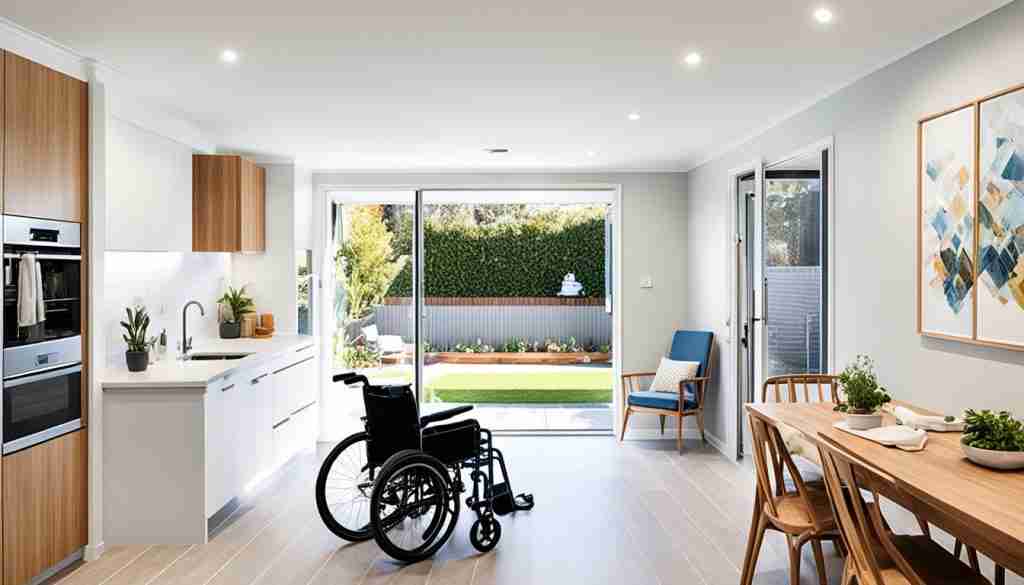
Safe Bathroom and Toilet Configurations
Having safe bathrooms and toilets is very important. Hobless showers reduce the risk of falling. This keeps everyone safe7. Bathrooms with strong walls can have grab bars added. These bars help people stay independent and safe6.
Future-Proof Structural Reinforcements
To make homes ready for any need, they include wide doors and halls. This helps people in wheelchairs and with other aids. It’s not just for the elderly, it helps everyone, including families with kids57. These changes keep homes working well over the years, fitting the changing needs of all Australians5.
| Feature | Benefit |
|---|---|
| Step-Free Entry | Aids in barrier-free living spaces and accessibility |
| Hobless Showers | Reduces trip hazards for safe bathroom use |
| Reinforced Bathroom Walls | Allows for future grabrail installations |
| Wider Doors and Corridors | Improves accessibility for mobility aids |
These elements are crucial for improving homes. They help the elderly, the aging population, and everyone else. They create open, safe living environments for all6.
Seniors Livable Housing Design in Australia
Making homes friendly for seniors is very important in Australia. It helps build strong and welcoming communities for older people. Special home designs let seniors live in their own homes safely and comfortably. New houses must follow the Silver Level Livable Housing Design Standards. This means they should have wide doorways, easy to use bathrooms, and entrances without steps5.
Some places in Australia, like Victoria and Queensland, have made these rules official5. They mix different Livable Housing Design ideas to create homes that are good for all seniors. In places like these, some new apartments must be very easy to use, with a lot of safety features5. The rules also say there must be a toilet on the first floor that’s easy for seniors to use8.
The rules also talk about how houses and apartments should be easy to get into and move around in. They must have space for things like grab bars. Doors and corridors must be wide and easy to use8. These changes help seniors live more independently and reduce the need to change their homes later on1.
In Australia, many people may need these types of homes. More than half the houses will have a disabled person living in them at some point1. With many people with disabilities in the country, building homes that are easy to live in is very important. Homes are also where most accidents happen. Designing homes that are safe and easy to use can help prevent these accidents1.
People in Australia support these efforts. They know that adding livable features to homes makes them better for everyone. By pushing for these changes, Livable Housing Australia is helping seniors and everyone else. They are making sure that new homes are built for safety and to welcome seniors into the community.
| Feature | Silver Level | Platinum Level |
|---|---|---|
| Entry Access | At least one level entrance | Multiple level entrances |
| Door Width | 820 mm | 1000 mm |
| Corridor Width | 1000 mm | 1200 mm |
| Bathroom Configuration | Step-free shower entry | Fully accessible bathroom |
Economic and Social Benefits of Livable Housing
Adding Livable Housing Design (LHD) early in senior homes is a big plus. It’s 22 times cheaper to add these features at the start (at the silver level) than to do it later when needed unexpectedly1. This early choice saves money and keeps homes safe and easy to use.
Cost-Effectiveness of Early Adaptation
Many new home owners and older adults see safety and usability in homes with LHD features1. Putting these in from the beginning can cut the cost of updates later. With more aging people, there’s a growing need for homes that are easy to live in. This is smart for the economy.
The Livable Housing Design Guidelines explain 15 important design features. They tell how to meet different performance levels, like silver, gold, and platinum. You can use these rules in new or old homes or apartments, but they’re not a must. This way, they’re easy to follow and fit well1.
Enhanced Quality of Life
Livable housing boosts seniors’ lives with features like no-step entries and easy-to-use bathrooms. These add-ons cut the chance of falling and lower the cost of treating fall injuries. Such injuries make up most falls in Australia and are expensive to treat1.
Social Participation and Inclusion
Easy-access homes help seniors join in more with others. By making homes that work well and are safe, older people can do more in their neighborhoods. This design idea fights feeling left out, making retirement communities places of mixing instead of going solo.
A survey from the Australian Network for Universal Housing Design shows the need for clear rules and teaching about easy-access homes. This mix of rules and teaching helps all understand the value of such homes9. It gets more people to see why easy-access housing matters, helping everyone join in better in society and the economy.
Implementing Age-Friendly Features in New Homes
It’s key to notice the need for senior-friendly home modifications as Australia’s population ages. In Western Australia, those 65 and older will grow to over 500,000 by 202610. Many older Australians are choosing to stay in their homes11. This makes aging in place renovations very important.
Developers must use universal design principles to add accessibility upgrades for elderly homes. Australia’s new Livable Housing Design Standard supports staying at home as we get older with features like step-free entry11. In October 2023, Queensland will have a similar standard for eco-friendly, universally designed homes11.
Making adaptable housing for seniors means adding things like wider doorways for wheelchairs and first-floor rooms. It’s also found that families with kids nearby want to stay put more11. This points out the need for homes that can change with their owners over time.
Many older people who rent in Western Australia struggle to find suitable homes10. This shows how critical it is to have affordable, easy-to-reach housing options. Queensland is working on this with grants and projects to make communities more age-friendly12.
Putting these features in homes helps everyone. And it shows a commitment to a society where everyone’s needs matter. By making these changes now, we can create homes that support older adults’ happiness and independence for years to come.
Conclusion
The pursuit of seniors livable housing design in Australia means more than updating homes. It’s creating a place where everyone, no matter their age or needs, can live in dignity and freedom. By following Livable Housing Design Standards, places like Northern Territory and Queensland are making housing more welcoming. They started in October 2023. Then, the Australian Capital Territory joined in January 2024. Victoria came next in May 2024, and South Australia plus Tasmania will follow in October 202413.
Setting up accessible features in homes doesn’t cost as much as we might think, about $2,900 to $4,400 for each home type13. This is a smart move that the Australian Government supports. It is part of their plan to make life better for older people by having buildings that are easy to get around in14. These changes make it easier for seniors to stay where they like living. They can enjoy a better life and stay connected with others easier.
Thinking about how a home is designed, even though it’s a small part of the cost, really matters. It can make big differences in how well a project works and how much it costs to keep it going later on. These improvements might cut down on health care costs, a big problem in places like England. There, bad housing makes the NHS spend £1.4 billion every year15. In Australia, better building standards and letting in more natural light can help older people. It might lower the chance of them feeling down or getting hurt15.
Thanks to LHA’s recommendations, Australia is getting ready for a better housing future. Everyone will benefit from these changes. They make sure houses are a great place for older folks to live, making everyone happier and healthier.
FAQ
What is seniors livable housing design in Australia?
What are the core principles of Livable Housing Design (LHD) for seniors?
What is the role of Livable Housing Australia (LHA)?
What key elements make up Livable Housing Design?
How do these housing designs benefit seniors?
What is meant by “aging in place” design?
What economic benefits does Livable Housing Design offer?
How can seniors’ homes be modified to be more accessible?
How are local and state governments supporting Livable Housing Design?
What is the significance of the Silver Level Livable Housing Design Standards?
What future-proofing measures are recommended for senior-friendly homes?
Source Links
- https://livablehousingaustralia.org.au/wp-content/uploads/2021/02/SLLHA_GuidelinesJuly2017FINAL4.pdf
- https://www.vba.vic.gov.au/building/regulatory-framework/ncc-2022/livable-housing-design-requirements
- https://ncc.abcb.gov.au/news/2022/new-livable-housing-design-requirements
- https://mbc-group.com.au/livable-housing-design-in-australia/
- https://dcp.newcastle.nsw.gov.au/getattachment/2f9bb7ef-1a6a-4dc2-a9ff-c33a943d1e32/Section-C13-Liveable-housing.pdf
- https://www.capitalproperties.com.au/news/livable-house-rules/
- https://dipl.nt.gov.au/lands-and-planning/building/livable-housing-design-in-national-construction-code-2022
- https://www.kbdimembers.org.au/livable-housing-design-for-new-australian-bathrooms/
- https://anuhd.org/wp-content/uploads/2020/03/anuhd_survey_report.accessible.pdf
- https://www.wa.gov.au/system/files/2021-03/Ageing-with-Choice.pdf
- https://universaldesignaustralia.net.au/category/housing-design-guidelines/housing-design-policy/
- https://www.planning.org.au/documents/item/9318
- https://www.honeycombaccess.com.au/post/embracing-change-the-ncc-2022-updates-in-housing-accessibility
- https://eprints.qut.edu.au/47289/1/47289A.pdf
- https://www.ovga.vic.gov.au/case-good-design-housing-guide-government

